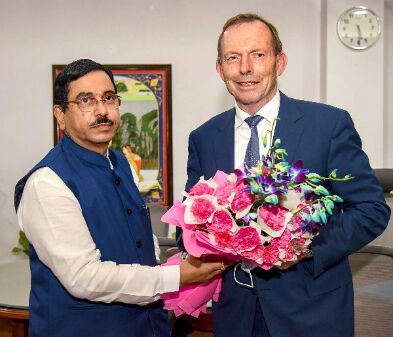Thawing relations
Tony Abbott’s two-day sojourn could provide depth and diversity to the already deepening India-Australia economic ties, and offer new hope for CECA

It is not often in the world of diplomacy that a country fields one of its leading political figures to engage with nations that matter the most in a world driven by trade and commerce at an unprecedented scale.
Last week, former Australian Prime Minister Tony Abbott decided to spend four days in New Delhi in a different role, as PM Scott Morrison's special envoy to India — a move that underscores the country's pathway to implement a plan to transform its economic ties with India by 2035.
During his August 2-6 sojourn, the former PM discussed with ministers of commerce, coal and mines, energy, power, finance and NITI Aayog, and signed off with a call to the Indian Prime Minister. Besides embarking on the plan approved in late 2018, Abbott's visit was aimed to rekindle negotiations with India on the Comprehensive Economic Cooperation Agreement (CECA) which has been stalled since he stepped down from his office in 2015. His dream of completing the pact after entering into a Free Trade Agreement with China that year remained an unfinished task.
With India unwilling to go along with the Regional Comprehensive Economic Partnership which is expected to roll out early next year, and New Delhi's inability to become a member of the Asia Pacific Economic Cooperation, CECA is a preferred route for many countries to expand bilateral trade and investment with one of the largest markets in the world.
In June this year, during a virtual meeting between PM Modi and Scott Morrison, both sides decided to restart negotiations on CECA. With global trade and the economy facing a downturn following the outbreak of the global health pandemic, the bilateral trade between the two countries during 2020 stood at USD 24.4 billion down from USD 29 billion during 2017-18. India is now ranked as the 7th largest trade partner and 6th largest export market for Australia. Indian imports include coal, copper ore and concentrates, gold, vegetables, lentils, fruits, nuts and wool.
Separated by the ocean and preferring to focus on trans-pacific for decades, the India-Australia relationship entered a transformational phase during the last 15-odd years — expanding to acquire depth in areas including agriculture, critical minerals, energy, education, and science and technology. Economic cooperation, trade and investment remain areas of special focus.
The trajectory of bilateral engagement remains on the rise with India and Australia upgrading ties this year to a Comprehensive Strategic Partnership, encompassing areas outside the narrow confines of military ties. Besides democratic values, both sides share a vision on the Indo-Pacific amid the rising challenge from China in the region.
India now awaits scheduling the first 2+2 meeting between the foreign and defence ministers, a meeting that would complete the set with India having similar engagements with the two other members of Quad — Japan and the United States.
The discussion was centred upon how both countries can further strengthen bilateral trade, investment and economic cooperation which, in turn, could assist India and Australia address certain challenges as the world prepares for a post-pandemic new order.
Can there be convergence as Australia seeks to increase cooperation with India, eyeing as it does have a huge potential in ten sectors while India is seeking to expand its manufacturing capacity? How does the policy intersect with India's 'Atmanirbhar Bharat' vision? Does it also dovetail with its avowed grand plan to attract global manufacturers looking to exit China? Will India emerge as a part of an alternate global supply chain that countries are keen to develop?
Ahead of Abbott's visit to India, Australian High Commissioner Barry O'Farrell described it as a commitment to strengthen the economic relationship, deepen trade and investment links with India and take the economic relationship to the next level, with emphasis on building secure and resilient supply chains.
Australia visualises that over the next two decades, India would require goods and services that it can offer in areas like agriculture, education, skill training and health — a sector that assumes immense importance as COVID19 showed how even developed countries were found wanting in terms of inadequate infrastructure. The projection includes India emerging as the third-largest economy in the world in less than a decade, despite a setback during 2020.
The basis for Australia's interest in developing trade and economic ties with India lies in the India Economic Strategy, aimed to navigate the relationship from "potential to delivery" by 2035. Prepared by former DFAT Secretary Peter Varghese, the 500-page document identifies a three-pillar strategy focussing on economics, geo-politics and people. Among the sectors where Australia has a competitive edge, education is a flagship sector. It constitutes one of the largest services sector exports, recording USD six billion with a little over 1.15 lakh Indian students studying in Australia.
As for people, Australians of Indian origin and Indian residents are the fastest growing community, currently numbering 7.21 lakh. Indian are also the largest source of skilled migrants. Just as the community played a role in the transformation of relations with the United States, can India expect a similar run down under to move the ties from traditional love for cricket and bonding through curry and Commonwealth?
Views expressed are personal



